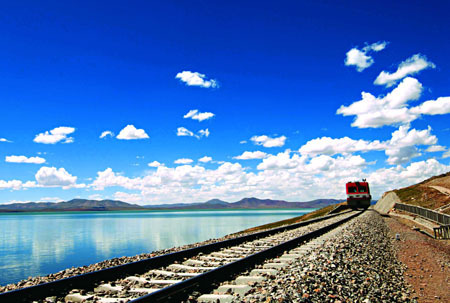| To enhance the protection of the water environment, Tibet had set up eight different kinds of environmental testing stations, 61 water quality-monitoring stations and six water and soil conservation monitoring stations by the end of 2006. A large-scale pollution prevention and control action in drainage areas, lasting 10 years and costing 9.24 billion, is being implemented. This action mainly aims to protect the water and air environment and dispose the solid waste harmlessly in the drainage area of the "Five Rivers" [the Yarlung Zangbo, Lhasa, Nyang, Nyangqu and Yarlung], thus ensuring that the environmental quality in the drainage areas is controlled within the set standard range for the functional area and a control system for disposing solid waste is set up to realize quantity reduction and the harmless disposal of solid waste of all kinds.

Construction of the Qinghai-Tibet Railway has not brought damage to the water quality of the Cona Lake.
The drainage areas of "Five Rivers" are the important ones for Tibet's national economy and social development. In those areas lie rich land, many minerals, photovoltaic and water energy sources, rich biological diversification and sample water resources, and developed agriculture and animal husbandry; industry has some basis, urban development is rapid, but the environmental pollution gradually emerges. The key range of the plan for pollution prevention and control in the drainage area lies in the trunk stream of the Yarlung Zangbo River and entryway sections of the "four other rivers" and the river section by the cities (towns) in the drainage area of the "five rivers, involving 32 county towns belonging to four prefectures or cities, i.e. Lhasa, Xigaze, Shannan and Nyingchi, and covering an area of some 300,000 square km.
In addition, Tibet has defined the allowable permitted assimilative capacity of water bodies and air in the drainage areas in accordance with the analysis of regional economic and social development and environmental capacity, and worked out the plan for the control of the total volume of water pollutant and air pollutant discharges. It assigned the detailed index of total volume control to each city (county), strictly adhered to the principle of total volume control and the principle of "giving priority to the protection of drinking water", mapped out the plan for the prevention and control of water pollution, air pollution, noise pollution and solid waste pollution, and listed key projects for the relevant pollution prevention and control.
According to the short-term goals set by the plan, the rate of domestic sewage treatment up to discharge standards will reach 60 percent, the rate of industrial waste water up to discharge standards 90 percent, and the rate of industrial waste gas up to discharge standards, the rate of noise up to standard at the boundary of industrial and mining enterprises, the rate of noise up to standard at the boundary of construction sites, and the rate of domestic trash disposal will all reach 85 percent in the key cites (towns) in the drainage areas of the "Five Rivers" by 2010. The rate of domestic sewage treatment up to discharge standards will reach 50 percent, the rate of industrial waste water up to discharge standards 80 percent, the rate of industrial waste gas up to discharge standards 75 percent, and the rate of noise up to the standard at the boundary of industrial and mining enterprises, the rate of noise up to standard at boundary of construction sites, and the rate of domestic trash disposal will all reach 80 percent in the main urban areas. |





